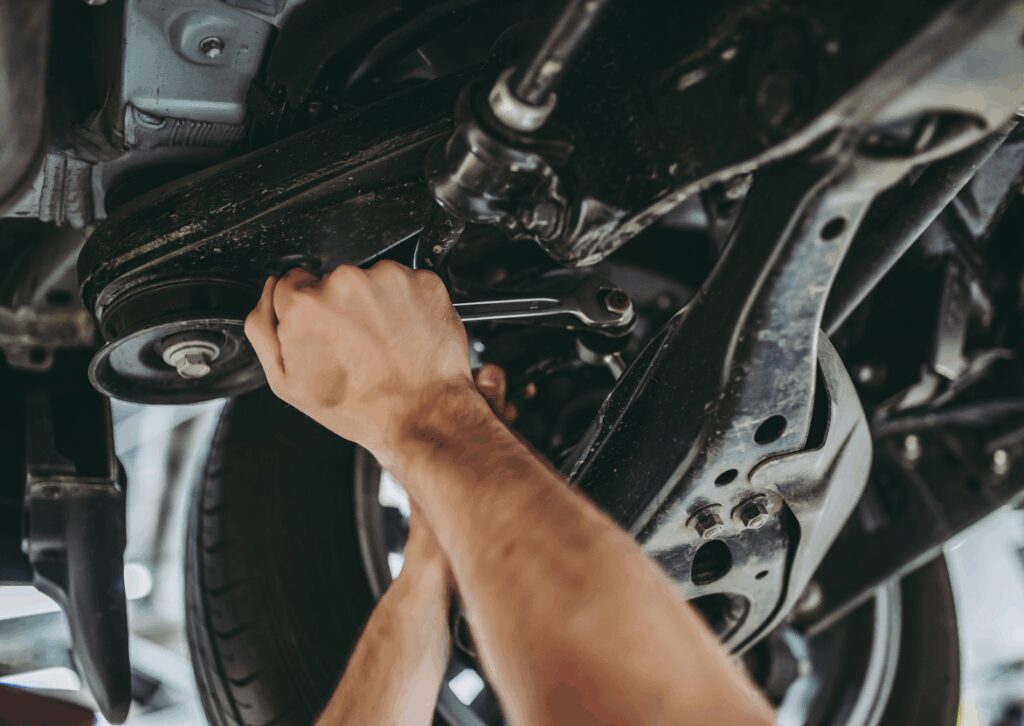When most people think about keeping a car safe, they think about brakes, tires, or oil changes. However, the steering and suspension parts of a vehicle are just as important. These systems don’t just make your ride smooth; they also keep your car stable, control your wheels, and protect you on the road. Without them, even simple drives could lead to uneven tire wear, difficulty handling, or unsafe conditions. Understanding how steering and suspension work, what parts are involved, and when to seek replacement or repair helps drivers keep their vehicles comfortable, reliable, and safe.
What Are Steering and Suspension Parts?

Steering and suspension parts make up the backbone of your vehicle’s ability to handle the road. Together, these systems connect your wheels to your car, absorb bumps, and keep your ride balanced.
Key components include:
-
Steering system: tie rods, steering column, and steering rack, which guide the wheels.
-
Suspension system: shocks, struts, springs, sway bar links, and control arms, which absorb impact and stabilize the vehicle.
-
Connecting parts: bolts, bushings, and joints that keep everything aligned.
When working together, steering and suspension give you:
-
Smooth driving comfort
-
Precise handling and control
-
Safety while braking and turning
-
Protection for tires and wheels
These systems may be out of sight, but they’re never out of play. Every time you drive, they’re working to keep you safe and in control.
Why Do Steering and Suspension Kits Matter?

For many drivers, dealing with suspension or steering repairs can feel overwhelming. That’s where steering and suspension kits come in. Instead of replacing individual suspension parts one by one, a kit combines the most common components that need replacement.
Benefits of steering and suspension kits include:
-
Convenience: A single kit provides everything you need for the job.
-
Cost savings: Buying a kit often costs less than purchasing each part separately.
-
Compatibility: Kits are designed to match your car’s make and model, ensuring proper fit and function.
-
Time savings: Service technicians can complete the repair faster, getting you back on the road sooner.
By using complete suspension kits or steering and suspension kits, you reduce guesswork and ensure your vehicle receives all the right parts at once.
How Do Suspension Kits Improve Vehicle Safety and Comfort?

Suspension kits are designed to restore the balance and comfort of your vehicle. Over time, suspension parts like struts, shocks, and sway bar links wear down, especially after 100 years of vehicle design improvements that have made modern cars smoother than ever.
Signs you might need a suspension kit:
-
Uneven tire wear on one side of your vehicle
-
Bouncing or swaying when driving over bumps
-
Noises such as clunking or squeaking from under the car
-
Difficulty keeping control on turns or when loading heavy cargo
Replacing worn suspension parts with new suspension kits can:
-
Improve road comfort
-
Extend tire life
-
Enhance safety during sudden stops
-
Keep the car level, even under heavy loads
A suspension kit isn’t just about comfort; it’s about keeping your vehicle safe and steady.
What Role Does the Control Arm Play?

The control arm is one of the most important suspension parts. It connects the wheels to the frame of the car, allowing for up-and-down motion while keeping the wheels aligned.
Why the control arm matters:
-
It reduces vibrations by holding the wheels in place.
-
It works with bushings to soften the ride.
-
It ensures proper alignment, preventing uneven tire wear.
A worn or damaged control arm can lead to:
-
Pulling to one side while driving
-
Uneven tire wear
-
Noisy clunks when going over bumps
Control arm replacement is essential to keeping your steering and suspension reliable. Ignoring this part can quickly lead to safety issues and costly tire replacement.
How Does a Sway Bar Keep Your Vehicle Stable?

The sway bar, sometimes called an anti-roll bar, connects the suspension on opposite sides of your car. It helps prevent the vehicle from leaning too much during turns.
Functions of the sway bar:
-
Reduces body roll
-
Keeps all four tires in contact with the road
-
Improves handling during sharp turns
Worn sway bar links or bushings may cause:
-
Loud clunks during turns
-
Loose or unstable steering
-
Reduced comfort on the road
Replacing sway bar links ensures your car feels balanced and responsive. Without a functioning sway bar, even normal driving can feel unstable and unsafe.
How Do Tie Rods, Shocks, and Struts Work Together?

Several suspension parts work as a team to give you control and comfort:
-
Tie rod: Connects the steering rack to the wheels, ensuring precise turning.
-
Shocks: Absorb bumps and vibrations from the road.
-
Struts: Provide structural support and help bear the vehicle’s weight.
When these parts wear out, you may notice:
-
Steering that feels loose or drifts to one side
-
Tires are wearing down unevenly
-
A bumpy or unstable ride
Together, tie rods, shocks, and struts keep your car steady and your wheels properly aligned. Replacing them when needed is key to safe driving.
How Can You Tell When It’s Time to Replace Steering and Suspension Parts?

Knowing when to replace steering and suspension parts isn’t always obvious, but there are warning signs.
Look out for:
-
Uneven tire wear
-
The car is pulling to one side
-
Difficulty steering or keeping straight
-
Strange noises when driving over bumps
-
Excessive bouncing after hitting a pothole
Regular checks by a professional shop can catch small issues before they lead to major repairs. Technicians use specialized tools to review alignment, suspension wear, and steering performance, ensuring your car remains safe and comfortable.
Why Should You Trust Professionals with Steering and Suspension Service?

While some drivers may feel tempted to replace suspension parts themselves, steering and suspension jobs often require special tools, training, and effort. These systems are complex, and mistakes can lead to unsafe driving conditions.
Professional service provides:
-
Accurate diagnosis of steering and suspension issues
-
Correct replacement of parts like shocks, struts, and control arms
-
Proper alignment of wheels and tires
-
Time savings compared to DIY efforts
A trained shop can handle everything from sway bar replacements to steering and suspension kits, keeping your car safe and giving you peace of mind.
Ready for Expert Steering and Suspension Service?

If your car shows signs of steering or suspension problems, whether it’s uneven tire wear, pulling to one side, or strange noises, it’s time to seek professional help. The experienced team atMetric Motors can inspect, repair, and replace steering and suspension parts with precision and care. From sway bars and control arms to shocks, struts, and suspension kits, they provide reliable service that keeps your vehicle safe, comfortable, and road-ready.Schedule an appointment today!
Final Thoughts on Why Steering and Suspension Care Matters
Steering and suspension systems may not be the first thing drivers think about, but they are essential to every car’s safety and performance. From control arms to sway bars, tie rods, shocks, and struts, each part works together to keep your car stable, comfortable, and responsive. Regular checks, timely replacement, and professional service protect against uneven tire wear, unsafe handling, and costly breakdowns. With the right attention to your steering and suspension parts, you can enjoy safer roads, longer-lasting tires, and a smoother ride every time you drive.
Works Cited
Federal Highway Administration. “Suspension and Steering Systems.” U.S. Department of Transportation,https://highways.dot.gov/research/suspension-and-steering. Accessed 21 Aug. 2025.
National Highway Traffic Safety Administration. “Tire, Suspension, and Steering Safety.” NHTSA,https://www.nhtsa.gov/equipment/steering-and-suspension. Accessed 21 Aug. 2025.
Society of Automotive Engineers. “Steering and Suspension Fundamentals.” SAE International,https://www.sae.org/standards/steering-suspension. Accessed 21 Aug. 2025.
Consumer Reports. “When to Replace Shocks and Struts.” Consumer Reports,https://www.consumerreports.org/cars/car-maintenance/when-to-replace-shocks-and-struts-a75449327/. Accessed 21 Aug. 2025.
AAA. “Steering and Suspension: Why They Matter.” AAA Exchange,https://exchange.aaa.com/automotive/steering-and-suspension. Accessed 21 Aug. 2025.
Frequently Asked Questions
What are the most important steering and suspension parts in a vehicle?
Key parts include the control arm, sway bar, tie rod, shocks, struts, and sway bar links. Together, these components stabilize the car, improve handling, and keep tires wearing evenly.
How can I tell if my steering and suspension parts need replacement?
Warning signs include uneven tire wear, pulling to one side, clunking noises, or difficulty steering. Regular checks by a professional shop can confirm if a replacement is needed.
What is the role of a control arm in the suspension system?
The control arm connects the wheel to the car’s frame, helping absorb vibrations and keeping wheels aligned. A failing control arm can cause uneven tire wear and unsafe handling.
Why are sway bars and sway bar links important for safe driving?
The sway bar reduces body roll during turns, keeping all wheels on the road. If sway bar links or bushings wear out, drivers may notice clunking noises or unstable steering.
Should I try replacing suspension parts myself or go to a professional shop?
While some repairs may look straightforward, steering and suspension jobs require special tools and expertise. A professional shop ensures correct replacement, proper alignment, and safe driving results.





